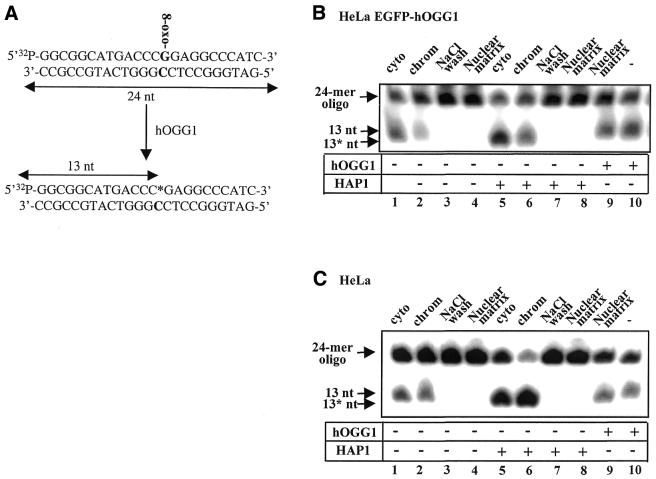Figure 4.
Comparative 8-oxoG cleavage activity in chromatin and nuclear matrix fractions. (A) Schematic representation of hOGG1 enzymatic activity. A 24 bp double-stranded oligonucleotide containing an 8-oxoG:C base pair at position 14 (in bold) was prepared as described (13) and 32P-labelled at the 5′ end of the 8-oxoG-containing strand. hOGG1 activity excises the 8-oxoG and cleaves the 32P-labelled 8-oxoG-containing strand 3′ of the lesion (β-elimination). The addition of HAP1 endonuclease induces subsequent cleavage of the terminal sugar phosphate. Both lyase and endonuclease activities produce a 13 nt 32P-end-labelled product when the reaction is run on denaturating polyacrylamide gels. (B) HeLa cells expressing hOGG1–EGFP or (C) non-transfected HeLa cells were fractionated as described in the Material and Methods and shown in Figure 2. Equivalent amounts of each fraction were incubated with the 8-oxoG:C-containing double-stranded oligonucleotide. Arrows indicate the positions of the 5′ radiolabelled substrate (24 bp) and reaction products as follows: 13 nt, 13mer product produced by hOGG1 strand nicking activity (lanes 1–4); 13* nt, 13 mer with a 3′-OH produced by the addition of HAP1 endonuclease where indicated (lanes 5–8). Ten nanograms of purified hOGG1 was added in control reaction mixtures with (lane 9) or without (lane 10) nuclear matrix extract. Cleavage products were analysed by PhosphorImaging after 20% denaturating PAGE.

